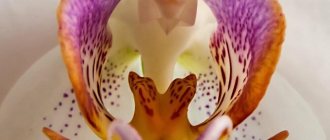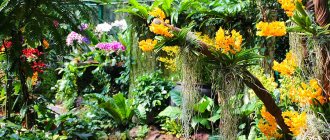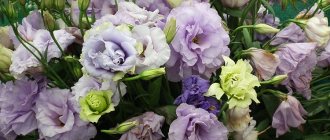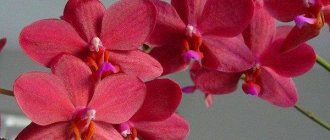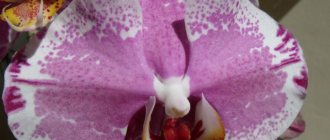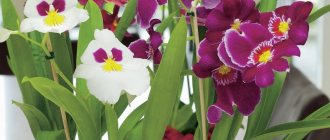Orchids are wonderful house plants that can decorate any interior. They are distinguished by long flowering, ease of care, variety of species, varieties, and colors.
It is customary to select phalaenopsis and some other species as indoor plants. These flowers are native to Australia but are found in the wild in Southeast Asia and the Philippines. There are more than 70 species of phalaenopsis, but only a few of them are grown as houseplants.
Description of the orchid
Almost all types of orchids are capable of blooming (subject to simple rules of caring for them) for a month. They look elegant and delightful, despite their simple structure. Each phalaenopsis bud consists of three outer sepals and three petals. In their center are the stamens and pistils. The orchid plant is an epiphyte (in nature it grows on other plants, using them as support).
When growing an orchid, it is important to consider that the most important part of it is the roots. They perform many functions:
- actively participate in photosynthesis together with leaves;
- attached to the substrate, due to which the plants maintain a vertical position;
- receive moisture and nutrients.
Important: epiphytic orchid flowers grow well at home. The main thing is to provide them with proper care so that they bloom profusely and for a long time.
Houseplant orchid homeland of the plant. Homeland of epiphytes
Epiphytes are plants that settle on other plants, but do not parasitize them, that is, they do not feed on their juices. Epiphytes obtain nutrients and energy through photosynthesis, and absorb moisture from air precipitation. The homeland of orchid epiphytes is the tropics of America and South-East Asia, where the struggle for survival has forced plants to evolve so much that, trying to rise higher to sunlight, they no longer need soil. Their aerial roots only need a small amount of nutritious soil from tree crevices, obtained as a result of rotting plant remains or blown there by the wind. The only harm that an epiphyte can bring to its support plant is damage to it due to strong growth.
Plant care
Having decided to purchase an orchid, you need to learn how to care for it. This plant, although unpretentious in care, requires compliance with certain rules.
Tip: it is best to place the flower on a western, eastern or north-eastern window sill. If you place a pot of plants on windows facing south, you should definitely darken it. Otherwise, the plant will get sunburn.
Lighting
The duration and regularity of flowering of phalinopsis directly depends on lighting. With a lack of light, the flower actively grows green mass and does not throw out arrows with buds. It is easy to notice the lack of light by the light color of the leaves and the absence of purple spots on their back side. The orchid requires 12-15 hours of daylight. Therefore, in winter she needs additional lighting using fluorescent lamps.
Temperature
The growing temperature of orchids plays an important role for the active growth of phalaenopsis. All biochemical processes in orchids occur only at an air temperature of 18-30 degrees Celsius.
Attention: for active growth and flowering, the air temperature in the room should be 20-25 degrees above zero.
Humidity
Indoor orchid grows and blooms well at air humidity of 60%. If the humidity in the room is insufficient, you need to install a humidifier or simply place an open vessel with water next to the pot.
Watering
Watering an orchid is the most important step in caring for it. This plant is moisture-loving, and drying out of the soil negatively affects its health. In addition, it receives all its nutrients either from the soil or from the water.
Tip: It is recommended to water the orchid with rain or filtered water. If tap water is used, it must sit for at least 24 hours.
Many beginners are interested in the question: when and how to water an orchid? You can tell when it’s time to water a flower by the condition of the soil in the pot. It must be completely dry. Also, the fact that it is time to water the plant is indicated by its light roots located on the surface of the pot.
Important: if the orchid has rich dark green roots, it means that everything is fine with its care.
You can water orchids in different ways. The most popular are:
- strait Water is poured along the edges of the flowerpot, and it flows down the walls into the tray. This leaves a small amount of liquid in the pot. Spills are most often used after transplanting plants into new pots;
- complete immersion in water. The pot with the plant is placed in a basin or other container with water at room temperature for 15 minutes. The plant itself absorbs as much moisture as it needs. This is ideal if the flower is healthy and strong;
- partial immersion. Used when necessary to moisten the soil;
- Place in a pan of water for 6 hours. In this way, not only the roots of the flower are moistened, but also the substrate. This method is used for orchids that have problems with the root system;
- warm shower. Phalaenopsis love this procedure and need it. In this case, the water temperature should be about 40 degrees Celsius. After a shower, the plant should not be immediately placed on a cool windowsill. It must cool down naturally. After taking a warm shower, the casting and socket are wiped dry with a napkin. The main thing is that water does not accumulate in the center of the outlet. Otherwise, the plant will begin to rot.
Priming
Despite the fact that almost all indoor flowers grow in the ground, the orchid is an exception. It requires a special substrate consisting of tree bark, sand, forest moss, and peat. It is better to purchase ready-made store-bought soil for orchids. But if you wish, you can prepare it yourself. For this you will need:
- pine bark (necessarily from a dead tree). It is thoroughly crushed, boiled and dried;
- sand (coarse);
- charcoal;
- expanded clay (you can add foam chips).
Advice: if you add fallen leaves from trees and crushed fern roots to the substrate, then you don’t have to feed it additionally for a long time.
Choosing a pot
Orchids are usually grown in translucent flowerpots. This makes it easier to monitor the condition of their root system. But sometimes experienced gardeners transplant them into ceramic pots. It is better to choose pots that are white or another light shade. Since they will bask less in direct sunlight. Orchids also grow well in wicker pots or baskets.
Circumcision
You can understand that an orchid needs pruning by the following signs:
- the peduncle began to turn yellow or turn brown;
- instead of a peduncle, only a dry stick remained;
- The shoot is green for more than 6 months, the plant does not bloom.
Tip: in many types of orchids, flowers can bloom repeatedly on the same arrow. Therefore, it is recommended to trim it after it has completely dried on its own.
The faded peduncle is cut off at a distance of 3 cm from the rosette. This can be done either with scissors or with a sharp knife. After pruning, the plant must be treated with a solution of potassium permanganate, brilliant green or activated carbon. In addition to the flower stalk, some types of orchids require pruning of leaves.
Top dressing
It is necessary to fertilize the flower regularly. Then it will bloom long and abundantly. Only store-bought complex additives are used as fertilizers. When applying fertilizers, it is important not to overdo it. Otherwise, the plants’ leaves will begin to crack due to the excess of beneficial minerals and macroelements.
Phalaenopsis are fed during the period of watering. Fertilizer is added to a container with warm and well-filtered water. Its quantity is always indicated on the label.
The best fertilizers for orchids are: “Bona Forte”, “Kristalon”, “Greenworld”. If a plant does not bloom for a long time, it can be stimulated with such preparations as: “Bud”, “Ovary”, “Plumen”.
Attention: in order for the orchid to absorb vitamins, fertilizing is carried out only on a moist substrate.
Transfer
When buying a healthy flower, there is no need to transplant it into another pot. The main thing is to make sure that the plant is not sick and is not susceptible to attack by pests.
Attention: it is recommended to replant orchids every 2-3 years. When the substrate loses its beneficial properties.
It is quite easy to understand that a flower needs to be transplanted into a new substrate. The bark becomes brittle, brittle, and emits an unpleasant odor. The flower is transplanted only after flowering. To do this, select a larger pot and add fresh soil to it.
Reproduction
Orchids are propagated using new shoots, seeds (but this cannot be done at home), and by dividing the rhizome.
To propagate an orchid by dividing the rhizome, it is enough to separate the young lateral shoots from it. They are cut off at the base of the leaves. It is recommended to carry out this procedure a month after the flower has faded. The branches on which new leaves have appeared and the length of the roots have reached 5 cm are planted separately. After separating the plant from the mother bush, the branch is dried during the day and planted in the substrate only the next day.
Attention: baby orchids should not outgrow the mother bush. Otherwise, they will not take root in the new place.
Typically, indoor phalaenopsis always develop lateral shoots. And if they are not there, this indicates improper care of the orchid. The appearance of new buds can be caused artificially. To do this, you need to find dormant buds on old branches and use a sharp blade to make cuts on them. The cut areas must be treated with an orchid growth regulator.
Is the orchid flower male or female?
It is believed that this plant was created for the fair sex. The meaning of the orchid flower for women is great. The plant gives them health, beauty, tenderness, and charm. It works on them no worse than an anti-aging cream. A flower will only surround a woman with care if she takes good care of it. The orchid should not be allowed to become sick or begin to fade.
If a man lives in the house, even if he is still a child, the orchid should not be bred. She spoils his aura, suppresses his masculinity. He becomes like a woman. The flower should not be placed in the bedroom or children's room for boys.
Diseases and pests
Orchids, like other indoor and garden flowers, sometimes get sick and various pests infest them. Diseases in these magnificent indoor flowers can be infectious or non-infectious. But they all happen due to improper care. It is quite easy to understand whether a plant is sick or not if you look closely at the condition of its leaves and roots. Let's take a closer look at what diseases and pests of orchids are dangerous.
Diseases
The most common diseases of orchids are:
- fungus. This happens due to excessive watering. The disease begins with rotting of the roots, which spreads to the leaves, stem and entire plant. It is impossible to cure the flower in this case;
- bacterial leaf spot. To do this, all diseased leaves are removed with scissors, and the sections are treated with brilliant green or activated carbon;
- anthracnose When treating a plant, it is necessary to remove all affected areas and treat it with Previkur, Profit or Sandofan;
- rust. The disease is quite serious, but can be treated. The plant is thoroughly washed under running water, and the substrate in the container is replaced with a new one. Then the flower is completely sprayed with a weak solution of manganese and treated with special preparations (“Orchid Manual”);
- hives. It is characterized by the appearance of large spots on the leaves, up to 3 cm in diameter. This occurs due to poor indoor air. It may be too dry or wet. The solution is to ventilate the room more often and maintain a certain temperature and air humidity in it.
Pests
Of the pests, orchids are attacked by:
- mealy worm. The disease manifests itself as yellowing and falling leaves;
- spider mite. Appears on leaves in dry indoor air. Spider mites can be easily spotted by the cobwebs formed on the leaves. At the initial stage of the disease, a regular soap solution will help, with which you need to thoroughly wipe all the leaves. If the flower is heavily damaged, only specialized products will help.
But if you care for the orchid properly, then it will not be afraid of either diseases or pests.
Orchid indoor plant. Orchid propagation
The orchid houseplant is so beautiful that you want to have more and more.
And sooner or later the question arises about how the flower reproduces and how to plant it correctly. Indoor orchid propagation involves the following types: - You can often see “air babies” on a flower. Most often they appear on flower stalks. You should wait until the shoot acquires its own roots, and then plant it in the ground for independent growth. Dendrobium and phalaenopsis reproduce in this way when they find themselves in a room with high temperature and sufficient humidity.
— Propagation by cuttings is suitable for phalaenopsis, vanda, and ascocentrum. The stem of such orchids has one apical growth point. A side shoot can become a cutting. You can also make a cutting from a faded flower shoot. The stem is cut into cuttings up to 15 centimeters long, they are laid on prepared soil, sand or moss. After which the vessel is covered with film. Each cutting must have at least several nodes with axillary buds.
Like many indoor flowers, orchids can reproduce by division. But this method is suitable only for a few representatives, for example, Cattleya, Laelia, Dendrobium, Miltonia. They differ in that they have several growth points, each of which produces a sprout. The right time for division is spring. During this period, the plant will take root better. To do this, it is removed from the pot, cleaned of the substrate or washed under a tap with warm water. The peeled rhizome is cut with a knife or pruning shears so that at least a few pseudobulbs remain on each piece. The sections must be sprinkled with charcoal powder.
Varieties for growing at home
Popular types and varieties of orchids that are suitable for home growing are:
- Arachnis. Externally, the plant looks like a spider. For active growth and flowering at home, the plant must be provided with a warm environment with high humidity and bright light. The flower is watered abundantly only during the period of active growth;
- Dendrobium phalaenopsis. Characterized by bright colors. The buds bloom regardless of the time of year. Their colors range from rich purple tones to snow-white;
- Phalaenopsis Sakura. Suitable for those who love Japanese culture. This is a gentle and romantic look that captivates flower lovers with smooth transitions of pastel shades;
- Royal orchid Vanda. Characterized by a large number of buds on one peduncle. At first the flowers are pale, but over time they become more saturated in color;
- Cattleya. A rather difficult flower to grow at home. Prefers a temperate warm climate. It is characterized by large leaves that reach 20 cm in diameter. The petals are covered with a waxy coating. It blooms for three weeks in all sorts of shades from soft pink to rich purple tones;
- Miltonia. The easiest flower to grow at home, which is just as popular, is phalaenopsis. Its leaves reach a length of 40 cm. They have an unusual gray-yellow color. And the velvety buds can come in all sorts of colors;
- Butterfly orchid (phalaenopsis). The most common type, which is sure to be present in the collection of indoor flower lovers. Its leaves are green and succulent. The color of the buds is varied. This is the most unpretentious flower to grow.
We looked at what varieties of orchids exist for home cultivation, how to properly care for them, and how to propagate them. If everything is done correctly, the plant will not get sick and will delight the owners with colorful, abundant and long-lasting flowering.
Brief characteristics and description of the plant
- Orchids are considered the oldest plants on Earth. Their trace was visible 65 million years ago. Prehistoric remains of this flower were found in Verona.
- Speaking about orchids, it is impossible not to note that this beautiful flower often has a soft purple hue. The orchid has managed to adapt to life throughout the world, except Antarctica.
- The total number of orchids in the world exceeds 25 thousand, and this count is inconclusive.
- The name “orchid” came to us from Ancient Greece and translated it means “testicle”, which confirms the similarity of the shape of the flower’s rhizome with the male part of the body.
What does it look like?
- An orchid is a monopodial flower that has one short stem that grows upward.
- Near the ground, the orchid flower has a rosette with succulent and thick foliage, which absorbs nutrients and moisture. Depending on the type of flower, the length of the leaves can reach sizes from 6 to 30 centimeters. Sometimes there is a characteristic light-colored ornament on the leaf plate.
- The orchid's peduncle is tall and slender. Large bright flowers bloom on it, resembling a butterfly. The sizes of these flowers range from 3 to 30 centimeters.
- Depending on the health of the plant, when an orchid blooms, from 5 to 40 flowers may appear on one peduncle. In the wild, their number can reach hundreds.
- This flower has thick roots of a flattened or rounded shape. With their help, the orchid easily adapts to growth on any surface.
- The size of the buds on an orchid can vary: from 1 to 13 centimeters in diameter. In this case, the inflorescences are usually localized in the axils of the leaves.
Where does it grow?
- Orchids grow on every continent except Antarctica.
- Most representatives of this flower can be found in the tropics. This is due to the fact that tropical latitudes are the most favorable environment for the growth of these plants. Most epiphytic orchid representatives grow in the tropics.
- In the post-Soviet space it will be possible to find up to 49 species of orchid plants.
